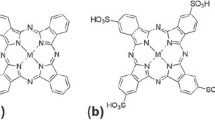Abstract
A novel molecular model of carbonyl-substituted phthalocyanine compounds used as the cathode material in a lithium-ion battery is demonstrated. Tetra-carboxyl and octa-carboxyl groups are substituted onto a phthalocyanine-conjugated system. The conductivities of phthalocyanine compounds are effectively improved by I2 doping, without affecting the capacity and energy density. Taking lithium as the counter-electrode, the electrochemical properties of the microparticles are investigated, and the electrochemical mechanism of carboxyl groups substituted with phthalocyanines is analyzed. The results indicate that carboxyl-substituted phthalocyanines have high specific capacities. After 20 or 50 cycles, they still retain capacities of about 300 and 500 mA · h/g for tetra-carboxyl- and octa-carboxyl-substituted phthalocyanines, respectively. The multiple carbonyl groups and the large numbers of electrons on the phthalocyanine-conjugated system are the two factors contributing to the high specific capacity.

A novel molecular model of carbonyl-substituted phthalocyanine compounds used as the cathode in a lithium-ion battery is demonstrated. Multiple carbonyl groups with high electrochemical activity are substituted onto a stable phthalocyanine-conjugated system, resulting in excellent conductivity and high specific capacity after using an iodine-doping technique; this could provide new ideas for electrode materials in lithium-ion batteries.










Similar content being viewed by others
References
Wu HP, Shevlin SA, Meng QH, Guo W, Meng YN, Lv K, Wei ZX, Guo ZX (2014) Adv Mater 26(20):3338–3343
Armand M, Tarascon JM (2008) Nature 451:652–657
Goodenough JB, Kim Y (2010) Chem Mater 22:587–603
Song ZP, Zhou HS (2013) Energy Environ Sci 6:2280–2301
Kalhoff J, Eshetu GG, Bresser D, Passerini S (2015) Chemsuschem 8:2154–2175
Liang YL, Tao ZL, Chen J (2012) Adv Energy Mater 2:742–769
Zhang LX, Liu ZH, Cui GL, Chen LQ (2015) Prog Polym Sci 43:136–164
Chen H, Armand M, Demailly G, Dolhem F, Poizot P, Tarascon JM (2008) ChemSusChem 1:348–355
Morita Y, Nishida S, Murata T, Moriguchi M, Ueda A, Satoh M, Arifuku K, Sato K, Takui T (2011) Nat Mater 10:947–951
Wang SW, Tao ZL, Chen J (2013) Chin Sci Bull (Chin Ver) 58:3132–3139
Reddy ALM, Nagarajan S, Chumyim P (2012) Sci Rep 2:960–965
Zeng RH, Li XP, Qiu YC (2010) Electrochem Commun 12:1253–1256
Liang YL, Zhang P, Chen J (2013) Chem Sci 4:1330–1337
Liang YL, Zhang P, Yang SQ (2013) Adv Energy Mater 3:600–605
Wang WK, Zhang YY, Wang AB (2010) Acta Phys-Chem Sin 26:47–50
Geng JQ, Bonnet JP, Renault S (2010) Angew Chem Int Ed 49:8444–8448
Xu LH, Yang F, Su C, Ji LL, Zhang C (2014) Electrochim Acta 130:148–155
Gnedenkov SV, Opra DP, Sinebryukhov SL, Tsvetnikov AK, Ustinov AY, Sergienko VI (2015) J Solid State Electrochem 17:2611–2621
Geng JQ, Bonnet JP, Renault S (2010) Energy Environ Sci 3:1929–1933
Tobishima S, Yamaki J, Yamaji A (1984) J Electrochem Soc 131:57–63
Han X, Qing G, Sun J, Sun T (2012) Angew Chem Int Ed 51:5147–5151
Bu P, Liu SQ, Lu Y (2012) Int J Electrochem Sci 7:4617–4624
Zhao L, Wang WK, Wang AB, Yu ZB, Chen S, Yang YS (2011) J Electrochem Soc 158:991–996
Genorio B, Pirnat K, Cerc-Korosec R (2010) Angew Chem Int Ed 49:7222–7224
Luo C, Huang RM, Kevorkyants R, Pavanello M, He HX, Wang CS (2014) Nano Lett 14:1596–1602
Chen HY, Armand M, Courty M (2009) J Am Chem Soc 131:8984–8988
Wang SW, Wang LJ, Zhang K, Zhu ZQ, Tao ZL, Chen J (2013) Nano Lett 13:4404–4409
Armand M, Grugeon S, Vezin H (2009) Nat Mater 8:120–125
Renault S, Brandell D, Gustafsson T (2013) Chem Commun 49:1945–1947
Renault S, Geng JQ, Dolhem F (2011) Chem Commun 47:2414–2416
Kim DJ, Je SH, Sampath S (2012) Rsc Adv 2:7968–7970
Gall LT, Reiman KH, Grossel MC (2003) J Power Sources 119:316–320
Nokami T, Matsuo T, Inatomi Y (2012) J Am Chem Soc 134:19694–19700
Haringer D, Novak P, Haas O (1999) J Electrochem Soc 146:2393–2396
Song RH, Xiang LD, Qiu YC, Wang YT, Huang WN, Li WS, Yang SH (2014) Electrochim Acta 146:447–454
Song ZP, Zhan H, Zhou YH (2009) Chem Commun 448–450
Liu K, Zheng JM, Zhong GM (2011) J Mater Chem 21:4125–4131
Xu J, Chen J, Chen L, Hu R, Wang SQ, Li SY, Ma JS, Yang GQ (2014) Dyes Pigments 109:144–150
Chen J, Zhang T, Wang SQ, Hu R, Li SY, Ma JS, Yang GQ (2015) Spectrochim Acta A Mol Biomol Spectrosc 149:426–433
Huang JH, Yang ZH, Wang SQ, Feng ZB (2015) J Solid State Electrochem 19:723–730
Muhammed A, Burak E (2015) J Solid State Electrochem 19:2275–2281
Yin HS, Deng JC, Xiang NJ (2006) Dyestuffs Coloration 143:17–19
Wang XJ, Huang ZH, Su ZM, Wang RS (1997) Chem J Chin Univ 18:1847–1850
Kobayashi N (2002) Coord Chem Rev 227:129–152
Chen J, Wang SQ, Yang GQ (2015) Acta Phys -Chim Sin 31:595–611
Liu TM, Wang FL (1989) Acta Chim Sin 47:967–970
Yoshihiro A, Seizo M, Ken O, Takayuki A, Michiko M, Kiyotaka S (2000) Electrochim Acta 46:77–81
Woehrle D, Kirschenmann M, Jaeger NJ (1985) J Electrochem Soc 132:1150–1152
Morita Y, Nishida S, Akutagawa N, Satoh M, Takui T (2008) Abstr Symp Phys Org Chem 2008:384–385
Asai Y, Onishi K, Miyata S, Kim SJ, Matsumoto M, Shigehara K (2001) J Electrochem Soc 148(4):A305–A310
Acknowledgments
We acknowledge the financial support from the National Natural Science Foundation of China (E0210) and the Talent Foud of Jiangxi University of Science and Technology (3402228077).
Author information
Authors and Affiliations
Corresponding authors
Rights and permissions
About this article
Cite this article
Chen, J., Zhang, Q., Zeng, M. et al. Carboxyl-conjugated phthalocyanines used as novel electrode materials with high specific capacity for lithium-ion batteries. J Solid State Electrochem 20, 1285–1294 (2016). https://doi.org/10.1007/s10008-016-3126-6
Received:
Revised:
Accepted:
Published:
Issue Date:
DOI: https://doi.org/10.1007/s10008-016-3126-6




